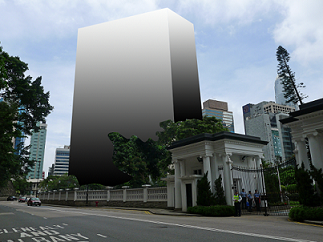Art Issues
- Art and JusticeThe latest article on a special issue topic is below. Other articles on the same topic can be read by clicking on the 'Archive' year and month on the side-bar.
決策也轉風向? | A Significant Shift in Decision-making?
John BATTEN
at 5:07pm on 22nd December 2019


圖片說明:
1. 2019年12月9日,香港中環舉辦的遊行,以爭取調查多場示威為題。
2. 由政府山關注組提供的藝術家構想圖,圖為聖公會擬於中環主教山興建的巨型醫院,已被城市規劃委員會否決。
照片由作者提供
Captions:
1. A demand for an investigation at protest rally, 9 December 2019, Central, Hong Kong.
2. Now rejected by the Town Planning Board: an artist’s rendition provided by the Government Hill Concern Group of the Sheng Kung Hui’s proposed high-rise hospital on Bishop Hill, next to Government House, in Central
All Photos: John Batten
(Please scroll down for English version)
自泛民在最近的區議會選舉中大獲全勝以來,對政府的反對與抨擊明顯更趨嚴苛 –– 我指的是來自建制派和政府委任組織的成員!
彈劾特首林鄭月娥的議案早前遭立法會否決,但在辯輪期間,一向聽聽話話的李慧琼狂轟林鄭政府失職,同時也狠批特首。當然,連珠爆發中也滲著不少與李氏自身的利益關係,因為很多現任區議員的民建聯同僚都在區選中落敗,議席不保,建制派在十八區只餘下一個區議會的控制權。李慧琼的攻擊可以說是摧毀性的,更斷言香港已瀕臨「無政府狀態」,政府一直不作為,「部份官員幾個月來甚至不發一言」。她特別點名批評律政司司長鄭若驊,指出她一開始便沒有解釋建議修訂引渡條例的全面影響,還有政府在宣佈擱置具爭議性的條例草案兩個月後始不情不願把它撤回。
上星期最令政府尷尬的事,要數獲警監會特聘,就警方處理反政府示威手法提供諮詢的五名海外獨立專家宣佈呈辭。警監會早於示威事件以前便已一直備受批評,因為它只有監察的角色,連委任為成員都是建制中人,也沒有完全的調查權。警監會沒有能力就投訴警方個案進行有結論的調查––因為這些投訴本來就是源自警察。林鄭政府責成警監會就示威提交報告,但這種調查根本無法滿足市民對全面獨立調查的期望。五位海外專家的看法與公眾一致!
首輪大型反政府暴力示威發生於8月24日,當日觀塘區內剛安裝的新設智慧燈柱被毀壞。現在,智慧燈柱技術諮詢專責委員(這真的是委員會的名字!)建議未來的智慧燈柱,應把攝錄機改成熱能探測器,用來監察路面交通情況,而且應進行獨立評估,以檢查個別燈柱是否合符市民的私穩關注。在示威浪潮開始以前,政府引入「智慧城市」政策,可以在沒有多少限制或討論的情況下推行。這個委員會連一名女性成員都沒有(竟然),但現在卻變得更為謹慎,即使電訊業向政府施壓,要求在未來安裝的智慧燈柱實施5G技術,委員會仍然小心處理政府在未有完全調查燈柱的私隱與情報影響下,打算在香港各處安裝400支智慧燈柱的建議。*
區選後首次在主要法定機關-城市規劃委員會-的會議上,委員史無前例地決定與推動文物保育及良好城市規劃的民間團體站在同一陣線,反對規劃署提出在中環歷史悠久的主教山上,由聖公會興建樓高135米的25層大型私家醫院的建議。反對方有一個小型的聯盟,由中西區關注組為成員的政府山關注組牽頭,另有多名現任及候任區議員,他們在城規會的全員會議上發表了一份合情合理的演說,並提出把高度限制訂於80米的反建議。保育倡議者對城規會提出的論點非常簡單:「在區議會選舉後,香港已經不再一樣:你不可以再忽視民意,只作政府建議的橡皮圖章」。而事實上政局方面也出現了真正的改變,城規會亦同意我們的想法!儘管我們仍然需要監視任何主教山的規劃,但城規會前所未有地站在民間團體及反對政府建議的一方,決定實施80米的樓高限制。
這有助於香港發展更佳的決策––而更重要的,是顯示政府不可如以往般只靠保皇黨支持。政府及制訂政策與措施的公僕必須比現在做得更好:市民都在看著。
*委員會的會議紀錄及討論文件,請參閱:
https://www.ogcio.gov.hk/tc/our_work/strategies/initiatives/smart_lampposts/committee/
原文刊於《明報周刊》,2019年12月20日
A Significant Shift in Decision-making?
by John Batten
Since the pan-democrat victory at the recent District Council election, there has been a significant toughening of objection and opposition to the government – from the pro-government camp and from members of its appointed institutions!
During the debate in the Legislative Council on the failed motion to impeach Chief Executive Carrie Lam, the usually docile Starry Lee launched a blistering attack on the failures of the Lam government, and on Lam herself. Of course, there was much self-interest in her virulent attack as many of her District Council DAB colleagues had lost their seats in the recent elections and the pro-government camp had lost control of all but one District Council. Lee’s attack was withering, and included the assertion that Hong Kong was almost in a “state of anarchy” and that the administration was non-functioning when “some of the officials…haven’t uttered a single word in the past months….” She particularly singled out the Justice Secretary Teresa Cheng for not initially explaining the full implications of the proposed extradition legislation, and the administration’s dithering to cancel the controversial bill after announcing its shelving two months earlier.
Last week, in a huge embarrassment to the government, the five members of the independent panel of overseas experts appointed to advise the Independent Police Complaints Council (IPCC) on police handling of the anti-government protests have quit. The IPCC has long been criticized even before the protests, as it only has a monitoring role, stacked with pro-government appointees and without full investigative powers. The Council is incapable of making conclusive investigations into complaints against police – as complaints against the police are first initiated by the police themselves. Tasked by the Lam government to report on the protests, the IPCC enquiry has never met the expectations of the public who demand a full independent investigation. The five overseas experts agreed with the public!
One of the first violent mass anti-government protests was on 24 August in Kwun Tong when newly installed smart lampposts were destroyed. Now, members of the Multi-functional Smart Lampposts Technical Advisory Ad Hoc Committee (yes, it is called that!) have suggested that smart lampposts should, in future, have their cameras replaced with heat sensors to monitor road traffic conditions and that an independent assessment should check individual lampposts to meet the public’s privacy concerns. Prior to the protests the government’s policy to introduce ‘smart city’ innovations could have been implemented without much restraint or discussion. This committee, without a single woman member (by the way), is now more circumspect about the government’s proposal to install 400 smart lampposts around Hong Kong without fully investigating the privacy and surveillance implications of these lampposts, and, despite the telecommunications industry pressuring the government to implement 5G technology inside future installed smart lampposts*.
In one of the first meetings of a major statutory body after the recent District Council elections, the Town Planning Board made an unprecedented decision to side with heritage and urban planning activists to overturn the Planning Department’s recommendation to support a huge 135m (25-storey) private hospital to be built by the Anglican Church (Sheng Kung Hui) on historic Bishop Hill in Central. In a loose alliance of opponents, led by the Government Hill Concern Group (an off-shoot of our Central & Western Concern Group) and including six district councilors, a rational and compelling presentation and a counter-proposal of an 80metres height limit was given to a full meeting of the Town Planning Board. The heritage activists’ argument to the Town Planning Board was simple: “After the District Council election, Hong Kong is different now: you can’t ignore the views of the public and just rubber-stamp government proposals.” And the political landscape really has changed, as the Town Planning Board agreed with us! Although we still need to monitor any future plans for Bishop Hill, a maximum building height of 80metres was imposed in an almost unprecedented decision by the Town Planning Board to side with activists against a government proposal.
This bodes well for better decision-making in Hong Kong – and, significantly, indicates that the government can’t casually rely on the support of its own supporters. The government and public servants who formulate policy initiatives must do much, much better: the public is watching.
*See the committee’s minutes and discussion papers at: https://www.ogcio.gov.hk/en/our_work/strategies/initiatives/smart_lampposts/committee/
This article was originally published in Ming Pao Weekly on 20 December 2019. Translated into Chinese by Aulina Chan.
